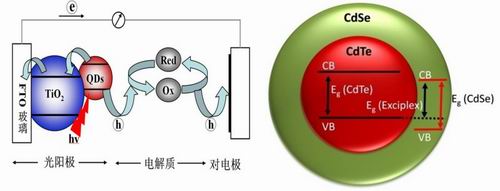Recently, the research work of Prof. Zhong Xinhua group, "Core/Shell Colloidal Quantum Dot Exciplex States for the Development of Highly Efficient Quantum -Dot-Sensitized Solar Cells", is published on ACS journal---Journal of the American Chemical Society (http://pubs.acs.org/doi/full/10.1021/ja4079804). This research result has refreshed the highest international standards in photo-electric conversion efficiency in quantum dots solar cells, which is about 6.76%. Solar cells can directly convert solar energy to electric energy, which is one of the most practical utilizations of the solar energy. Therefore, searching for low-cost, high efficient photo-voltaic technology is an efficient solution for the environment degradation and exhaustion of petro-chemical fuel. Owing to their high-conversion efficiency and simple preparation, dye-sensitized solar cells (DSC) are expected to gradually replace the traditional silica solar cells. QDSC are those using inorganic semi-conductor quantum dots to capture photons, replacing dye sensitizers in DSC. Compared with traditional dye molecules, quantum dots bear the merits of high absorption efficiency, broad absorption spectra, high stability and etc., especially the possibility of excitation of multi-excitons by one photon at a time, which makes the external quantum efficiency exceed 100%. Unfortunately, the highest conversion efficiency of QDSC at present significantly lags behind the DSC, yet its rapid development trend (from less than 1% to 6-7% in 5 years) predicts the brilliant prospect.
Development of High-efficient solar cell is the foundamental way for realizing its commercial applications. Supported by Prof. Tian He and Hua Jianli, the research group of Prof. Zhong Xinhua successfully drew on their deep research accumulation in DSC and developed the technology of higi loaded quantum dots deposition, which makes the application of pre-synthesized high-quantity quantum dots viable in QDSC, paving the way for the development of high efficiency quantum dots solar cells. The research group has designed and synthesized a reverse type-I CdS/CdSe core/shell structure quantum dots and CdSexTe1-x alloy quantum dots sensitizer, achieving a unification of wide spectral absorption and high efficient injection as well as photo-electric conversion efficiency of 5.4% and 6.4%, respectively. These research results have been published in CS Nano 2013, 7, 2115-5222; ACS Nano 2012, 6, 3982 -3991; Chem. Commun. 2012, 48, 11235-11237.

In this research work, the research group for the first time use the Type-II core/shell structure quantum dots as composite excited state to on one hand extend the absorption region to near-infrared zone, while on another hand achieve the separation of electrons and holes, benefiting the electron injection and transmission. This work combines the after-synthesis quantum dots deposition technology, eventually raises the QDSC efficiency to a new high-level and meanwhile makes the sensitized cells with liquid junction comparable to other complex-configurated cells in cell efficiency.




